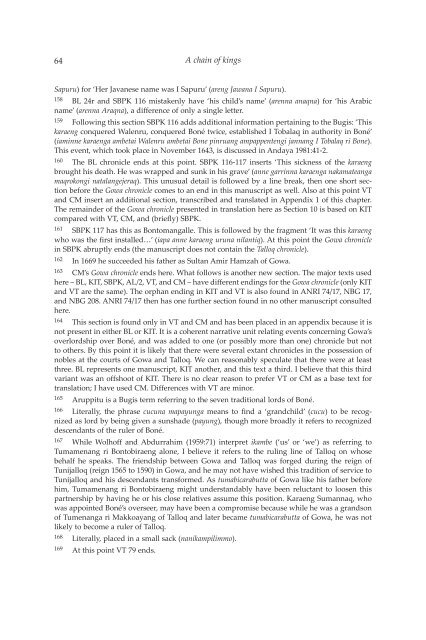A CHAIN OF KINGS - Books and Journals
A CHAIN OF KINGS - Books and Journals
A CHAIN OF KINGS - Books and Journals
Create successful ePaper yourself
Turn your PDF publications into a flip-book with our unique Google optimized e-Paper software.
64<br />
A chain of kings<br />
Sapuru) for ‘Her Javanese name was I Sapuru’ (areng Jawana I Sapuru).<br />
158 BL 24r <strong>and</strong> SBPK 116 mistakenly have ‘his child’s name’ (arenna anaqna) for ‘his Arabic<br />
name’ (arenna Araqna), a difference of only a single letter.<br />
159 Following this section SBPK 116 adds additional information pertaining to the Bugis: ‘This<br />
karaeng conquered Walenru, conquered Boné twice, established I Tobalaq in authority in Boné’<br />
(iaminne karaenga ambetai Walenru ambetai Bone pinruang ampappentengi jannang I Tobalaq ri Bone).<br />
This event, which took place in November 1643, is discussed in Andaya 1981:41-2.<br />
160 The BL chronicle ends at this point. SBPK 116-117 inserts ‘This sickness of the karaeng<br />
brought his death. He was wrapped <strong>and</strong> sunk in his grave’ (anne garrinna karaenga nakamateanga<br />
maqrokongi natalangejeraq). This unusual detail is followed by a line break, then one short section<br />
before the Gowa chronicle comes to an end in this manuscript as well. Also at this point VT<br />
<strong>and</strong> CM insert an additional section, transcribed <strong>and</strong> translated in Appendix 1 of this chapter.<br />
The remainder of the Gowa chronicle presented in translation here as Section 10 is based on KIT<br />
compared with VT, CM, <strong>and</strong> (briefly) SBPK.<br />
161 SBPK 117 has this as Bontomangalle. This is followed by the fragment ‘It was this karaeng<br />
who was the first installed…’ (iapa anne karaeng uruna nilantiq). At this point the Gowa chronicle<br />
in SBPK abruptly ends (the manuscript does not contain the Talloq chronicle).<br />
162 In 1669 he succeeded his father as Sultan Amir Hamzah of Gowa.<br />
163 CM’s Gowa chronicle ends here. What follows is another new section. The major texts used<br />
here ‒ BL, KIT, SBPK, AL/2, VT, <strong>and</strong> CM ‒ have different endings for the Gowa chronicle (only KIT<br />
<strong>and</strong> VT are the same). The orphan ending in KIT <strong>and</strong> VT is also found in ANRI 74/17, NBG 17,<br />
<strong>and</strong> NBG 208. ANRI 74/17 then has one further section found in no other manuscript consulted<br />
here.<br />
164 This section is found only in VT <strong>and</strong> CM <strong>and</strong> has been placed in an appendix because it is<br />
not present in either BL or KIT. It is a coherent narrative unit relating events concerning Gowa’s<br />
overlordship over Boné, <strong>and</strong> was added to one (or possibly more than one) chronicle but not<br />
to others. By this point it is likely that there were several extant chronicles in the possession of<br />
nobles at the courts of Gowa <strong>and</strong> Talloq. We can reasonably speculate that there were at least<br />
three. BL represents one manuscript, KIT another, <strong>and</strong> this text a third. I believe that this third<br />
variant was an offshoot of KIT. There is no clear reason to prefer VT or CM as a base text for<br />
translation; I have used CM. Differences with VT are minor.<br />
165 Aruppitu is a Bugis term referring to the seven traditional lords of Boné.<br />
166 Literally, the phrase cucuna mapayunga means to find a ‘gr<strong>and</strong>child’ (cucu) to be recognized<br />
as lord by being given a sunshade (payung), though more broadly it refers to recognized<br />
descendants of the ruler of Boné.<br />
167 While Wolhoff <strong>and</strong> Abdurrahim (1959:71) interpret ikambe (‘us’ or ‘we’) as referring to<br />
Tumamenang ri Bontobiraeng alone, I believe it refers to the ruling line of Talloq on whose<br />
behalf he speaks. The friendship between Gowa <strong>and</strong> Talloq was forged during the reign of<br />
Tunijalloq (reign 1565 to 1590) in Gowa, <strong>and</strong> he may not have wished this tradition of service to<br />
Tunijalloq <strong>and</strong> his descendants transformed. As tumabicarabutta of Gowa like his father before<br />
him, Tumamenang ri Bontobiraeng might underst<strong>and</strong>ably have been reluctant to loosen this<br />
partnership by having he or his close relatives assume this position. Karaeng Sumannaq, who<br />
was appointed Boné’s overseer, may have been a compromise because while he was a gr<strong>and</strong>son<br />
of Tumenanga ri Makkoayang of Talloq <strong>and</strong> later became tumabicarabutta of Gowa, he was not<br />
likely to become a ruler of Talloq.<br />
168 Literally, placed in a small sack (nanikampilimmo).<br />
169 At this point VT 79 ends.









![Am HaSefer [Volk des Buches] - Books and Journals](https://img.yumpu.com/20648352/1/174x260/am-hasefer-volk-des-buches-books-and-journals.jpg?quality=85)







